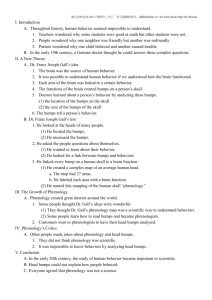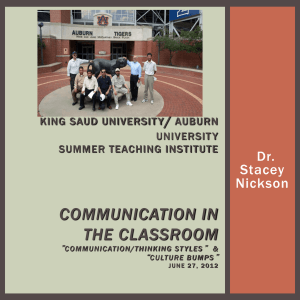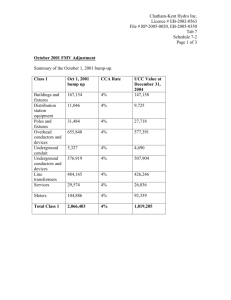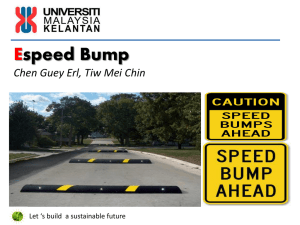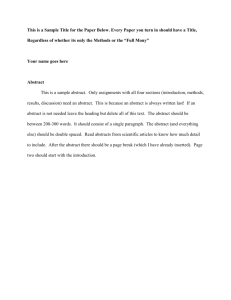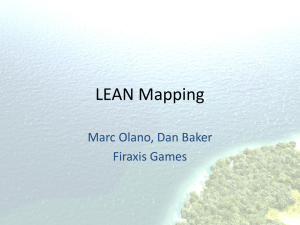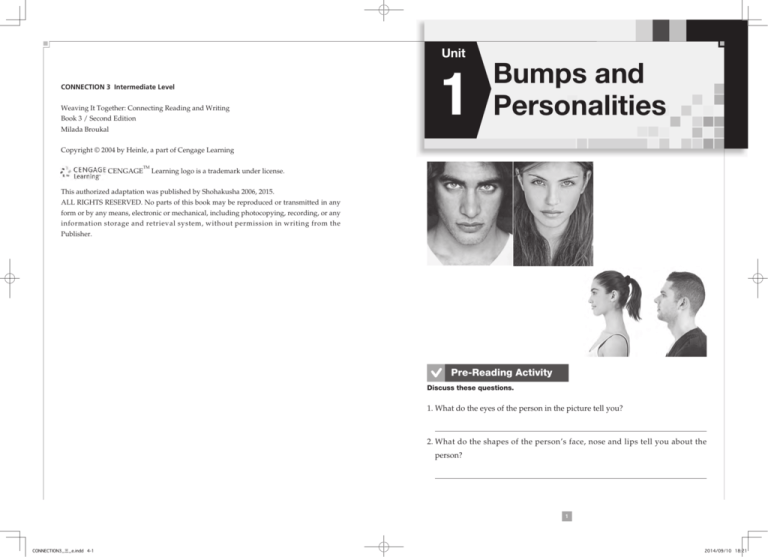
Unit
1
CONNECTION 3 Intermediate Level
Weaving It Together: Connecting Reading and Writing
Book 3 / Second Edition
Milada Broukal
Bumps and
Personalities
Copyright © 2004 by Heinle, a part of Cengage Learning
TM
CENGAGE
Learning logo is a trademark under license.
This authorized adaptation was published by Shohakusha 2006, 2015.
ALL RIGHTS RESERVED. No parts of this book may be reproduced or transmitted in any
form or by any means, electronic or mechanical, including photocopying, recording, or any
information storage and retrieval system, without permission in writing from the
Publisher.
Pre-Reading Activity
Discuss these questions.
1. What do the eyes of the person in the picture tell you?
2. What do the shapes of the person’s face, nose and lips tell you about the
person?
1
CONNECTION3_三_e.indd 4-1
2014/09/10 18:21
L ooking for the Main Ideas
L ooking for Details
R
eading
Track
shapes and sizes on the human head. They “read” these bumps to identify a
1
person’s talents and character. For example, a bump between the nose and
Have you ever been afraid of or attracted to someone just because of
way the person looks? When you first meet someone, it is not unusual to
Vtheocabulary
forehead is said to be present in people who have natural elegance and a
30
react to his or her appearance. But these are first impressions, and most
5
Phrenologists are not so much interested in health as they are in
possible, however, that a person’s appearance reveals more than we realize.
character and personality. They believe, for example, that a bulge in the
According to some experts, a person’s face, head, and body can reveal a
center of the forehead is typical of people who have a good memory and a
35
person who has strong moral character, while a bump just below this one is
or reading character from physical features. The ancient Greeks compared
a sign of generosity and a kind, good nature. Phrenologists say a bump just
the human face to the faces of various animals and birds, such as the eagle
above the tip of the eyebrow is found in people who love order and
and the horse. They believed people shared certain character traits with the
discipline, and a rise at the very back of the head is evident in people who
40
are very attached to their families.
thought to be loyal, brave, and stern. A person with an aquiline, or eaglelike,
Phrenology was developed in the early eighteenth century by Franz
nose was believed to be bold and courageous, as well as arrogant and self-
Joseph Gall, a doctor in Vienna. His interest began at school when he noticed
centered.
that boys with prominent eyes seemed to have the best memories. This led
Physiognomists study such features as the shape of the head, the
length and thickness of the neck, the color and thickness of the hair, and the
20
desire for knowledge. A small bump at the top of the head indicates a
Since ancient times, people have practiced the art of physiognomy,
animals they resembled. A person with an equine, or horselike, face was
15
courageous and adventurous person.
people assume that it takes time to find out what someone is really like. It is
great deal about personality.
10
love of beauty. A bump behind the curve of the ear is the sign of a
him to believe that a connection existed between appearance and ability. Dr.
45
Gall’s research interested many people, but he was ridiculed by other
shape of the nose, mouth, eyes, and chin. They believe that round-faced
doctors. When he died in 1828, he was a poor and bitter man. It was only
people are self-confident. Prominent cheekbones show strength of character,
many years later that Dr. Gall’s theories found support among some doctors
while a pointed nose reveals curiosity. Heavy arched eyebrows belong to a
and scientists, and today the art of phrenology has become more accepted.
decisive individual, while thin arched eyebrows signal a restless and active
(574 words)
personality. Almond-shaped eyes reveal an artistic nature. Round, soft eyes
belong to dreamers. Downturned lips reveal a proud character, while a long,
pointed chin indicates someone who likes to give orders.
A related — though not as ancient — art is phrenology, the study of
25
the bumps on the head. Phrenologists have identified 40 bumps of various
Notes
l. 1: be attracted to ~ = make yourself interested in ~ l. 3: appearance = the way someone looks on the
outside first impression(s) = the first general idea about someone at the first time l. 4: assume = think
that something is true without having information of it l. 6-7: a great deal = much, a lot l. 8: practice =
do (an activity) l. 12: resemble = look like equine = like a horse horselike = looking like a horse l. 13:
loyal = staying with someone and supporting him/her aquiline = thin and curved eaglelike = looking like
an eagle l. 14: bold = courageous = brave, not afraid l. 17: thickness ( ⇔ thinness) = the size (how thick,
not thin) of something, width (i.e., thick = wide ⇔ thick) l. 19: self-confident = feeling sure about your own
ability l. 20: curiosity = a strong wish to know about something arched = round shaped like an arch l.
21: decisive = able to decide something quickly thin = narrow ( ⇔ thick) restless = unable to stay still
(without moving) l. 23: downturned = fallen shaped, having a down shape proud = having pride or
respect to yourself l. 25: related = connected l. 26: bump(s) = a swelling or raised body part that is not
flat (i.e, rise) identify = understand
l. 31: adventurous = enjoying being in new, exciting situations l. 36: moral = having strong beliefs of right
and wrong things l. 37: generosity = being happy to be nice to people, for example, willing to give
someone kindness, money, gifts, time (i.e., generous) l. 38: order =controlled state, situation for example
following rules l. 39: discipline = the practice of training people to follow rules rise = bump evident =
clear, easily seen l. 40: attached to ~ = full of the feeling of loving someone or something l. 45: ridiculed
= laughed at in an unkind way
2
3
CONNECTION3_三_e.indd 2-3
Notes
2014/09/10 18:21
L ooking for the Main Ideas
L ooking for Details
R
eading
Track
shapes and sizes on the human head. They “read” these bumps to identify a
1
person’s talents and character. For example, a bump between the nose and
Have you ever been afraid of or attracted to someone just because of
way the person looks? When you first meet someone, it is not unusual to
Vtheocabulary
forehead is said to be present in people who have natural elegance and a
30
react to his or her appearance. But these are first impressions, and most
5
Phrenologists are not so much interested in health as they are in
possible, however, that a person’s appearance reveals more than we realize.
character and personality. They believe, for example, that a bulge in the
According to some experts, a person’s face, head, and body can reveal a
center of the forehead is typical of people who have a good memory and a
35
person who has strong moral character, while a bump just below this one is
or reading character from physical features. The ancient Greeks compared
a sign of generosity and a kind, good nature. Phrenologists say a bump just
the human face to the faces of various animals and birds, such as the eagle
above the tip of the eyebrow is found in people who love order and
and the horse. They believed people shared certain character traits with the
discipline, and a rise at the very back of the head is evident in people who
40
are very attached to their families.
thought to be loyal, brave, and stern. A person with an aquiline, or eaglelike,
Phrenology was developed in the early eighteenth century by Franz
nose was believed to be bold and courageous, as well as arrogant and self-
Joseph Gall, a doctor in Vienna. His interest began at school when he noticed
centered.
that boys with prominent eyes seemed to have the best memories. This led
Physiognomists study such features as the shape of the head, the
length and thickness of the neck, the color and thickness of the hair, and the
20
desire for knowledge. A small bump at the top of the head indicates a
Since ancient times, people have practiced the art of physiognomy,
animals they resembled. A person with an equine, or horselike, face was
15
courageous and adventurous person.
people assume that it takes time to find out what someone is really like. It is
great deal about personality.
10
love of beauty. A bump behind the curve of the ear is the sign of a
him to believe that a connection existed between appearance and ability. Dr.
45
Gall’s research interested many people, but he was ridiculed by other
shape of the nose, mouth, eyes, and chin. They believe that round-faced
doctors. When he died in 1828, he was a poor and bitter man. It was only
people are self-confident. Prominent cheekbones show strength of character,
many years later that Dr. Gall’s theories found support among some doctors
while a pointed nose reveals curiosity. Heavy arched eyebrows belong to a
and scientists, and today the art of phrenology has become more accepted.
decisive individual, while thin arched eyebrows signal a restless and active
(574 words)
personality. Almond-shaped eyes reveal an artistic nature. Round, soft eyes
belong to dreamers. Downturned lips reveal a proud character, while a long,
pointed chin indicates someone who likes to give orders.
A related — though not as ancient — art is phrenology, the study of
25
the bumps on the head. Phrenologists have identified 40 bumps of various
Notes
l. 1: be attracted to ~ = make yourself interested in ~ l. 3: appearance = the way someone looks on the
outside first impression(s) = the first general idea about someone at the first time l. 4: assume = think
that something is true without having information of it l. 6-7: a great deal = much, a lot l. 8: practice =
do (an activity) l. 12: resemble = look like equine = like a horse horselike = looking like a horse l. 13:
loyal = staying with someone and supporting him/her aquiline = thin and curved eaglelike = looking like
an eagle l. 14: bold = courageous = brave, not afraid l. 17: thickness ( ⇔ thinness) = the size (how thick,
not thin) of something, width (i.e., thick = wide ⇔ thick) l. 19: self-confident = feeling sure about your own
ability l. 20: curiosity = a strong wish to know about something arched = round shaped like an arch l.
21: decisive = able to decide something quickly thin = narrow ( ⇔ thick) restless = unable to stay still
(without moving) l. 23: downturned = fallen shaped, having a down shape proud = having pride or
respect to yourself l. 25: related = connected l. 26: bump(s) = a swelling or raised body part that is not
flat (i.e, rise) identify = understand
l. 31: adventurous = enjoying being in new, exciting situations l. 36: moral = having strong beliefs of right
and wrong things l. 37: generosity = being happy to be nice to people, for example, willing to give
someone kindness, money, gifts, time (i.e., generous) l. 38: order =controlled state, situation for example
following rules l. 39: discipline = the practice of training people to follow rules rise = bump evident =
clear, easily seen l. 40: attached to ~ = full of the feeling of loving someone or something l. 45: ridiculed
= laughed at in an unkind way
2
3
CONNECTION3_三_e.indd 2-3
Notes
2014/09/10 18:21
L ooking for Details
R eading
D iscussion
V ocabulary
L ooking for the Main Ideas
What are the meanings of the underlined words? Circle the letter of each correct
answer.
1. A person’s face can reveal a great deal about personality.
a. show
c. hold
b. cover up
d. identify
Circle the letter of the correct answer.
L
ooking for
Details
1. Physiognomists
believe
that .
a. you can improve your personality by studying your face
the
head is the most important part of the body
eading
Rb.c. physical
features reveal personality
2. The ancient Greeks believed that people shared certain character traits with
animals.
a. organs
c. habits
b. movements
d. connections
3. A person with a horselike face might be proud and stern.
a. noble
c. quiet
b. serious
d. confident
V ocabulary
d. people are like animals in many ways
2. Phrenologists .
a. “read” the bumps on people’s heads to treat their health problems
b. compare bumps on heads to see who is more attractive
c. believe the eyes are the “mirror of the soul”
d. study bumps on the head to determine character traits
4. A person with an eaglelike nose was believed to be arrogant and selfcentered.
a. honest
c. lonely
b. proud
d. brave
3. Dr. Gall’s ideas .
a. were at first not accepted by other doctors
5. Prominent cheekbones show strength of character.
a. healthy
c. noticeable
b. hollow
d. flat
6. A long, pointed chin indicates someone who likes to give orders.
a. covers up
c. encourages
b. points out
d. describes
7. A bulge in the center of the forehead is typical of people with a good memory.
a. lump
c. point
b. hole
d. mark
c. faithful
b. unhappy
d. popular
him admired
in his lifetime
ooking
for the
Main Ideas
Ld. made
L ooking for Details
Circle T if the sentence is true. Circle F if the sentence is false.
R
(T F)eading
1. Physiognomy is a modern practice.
V
(T F)ocabulary
3. Physiognomists study the shape of the head, face, and body.
(T F) 4. Phrenology is a much more ancient art than physiognomy.
(T F) 5. Dr. Gall was rewarded for his research later in life.
4
CONNECTION3_三_e.indd 4-5
c. are no longer discussed
(T F) 2. The ancient Greeks compared the human face to those of animals.
8. He died a poor and bitter man.
a. hopeful
iscussion
immediately considered the work of a genius
Db. were
5
2014/09/10 18:21
L ooking for Details
R eading
D iscussion
V ocabulary
L ooking for the Main Ideas
What are the meanings of the underlined words? Circle the letter of each correct
answer.
1. A person’s face can reveal a great deal about personality.
a. show
c. hold
b. cover up
d. identify
Circle the letter of the correct answer.
L
ooking for
Details
1. Physiognomists
believe
that .
a. you can improve your personality by studying your face
the
head is the most important part of the body
eading
Rb.c. physical
features reveal personality
2. The ancient Greeks believed that people shared certain character traits with
animals.
a. organs
c. habits
b. movements
d. connections
3. A person with a horselike face might be proud and stern.
a. noble
c. quiet
b. serious
d. confident
V ocabulary
d. people are like animals in many ways
2. Phrenologists .
a. “read” the bumps on people’s heads to treat their health problems
b. compare bumps on heads to see who is more attractive
c. believe the eyes are the “mirror of the soul”
d. study bumps on the head to determine character traits
4. A person with an eaglelike nose was believed to be arrogant and selfcentered.
a. honest
c. lonely
b. proud
d. brave
3. Dr. Gall’s ideas .
a. were at first not accepted by other doctors
5. Prominent cheekbones show strength of character.
a. healthy
c. noticeable
b. hollow
d. flat
6. A long, pointed chin indicates someone who likes to give orders.
a. covers up
c. encourages
b. points out
d. describes
7. A bulge in the center of the forehead is typical of people with a good memory.
a. lump
c. point
b. hole
d. mark
c. faithful
b. unhappy
d. popular
him admired
in his lifetime
ooking
for the
Main Ideas
Ld. made
L ooking for Details
Circle T if the sentence is true. Circle F if the sentence is false.
R
(T F)eading
1. Physiognomy is a modern practice.
V
(T F)ocabulary
3. Physiognomists study the shape of the head, face, and body.
(T F) 4. Phrenology is a much more ancient art than physiognomy.
(T F) 5. Dr. Gall was rewarded for his research later in life.
4
CONNECTION3_三_e.indd 4-5
c. are no longer discussed
(T F) 2. The ancient Greeks compared the human face to those of animals.
8. He died a poor and bitter man.
a. hopeful
iscussion
immediately considered the work of a genius
Db. were
5
2014/09/10 18:21
Unit
M aking Inferences and Drawing Conclusions
2
The answers to these questions are not directly stated in the reading. Write
complete sentences.
A nalyzing Ideas
1. Why did the Greeks compare humans to animals?
A nalyzing Images
An American
Holiday,
Hawaiian Style
2. Why did Dr. Gall want to study phrenology?
3. Why did other doctors ridicule Dr. Gall’s research?
D iscussion
Discuss these questions with your classmates.
L
ooking
for the
Main
Ideas
1. What
characteristics
of the
face and
body show good health? What
characteristics show bad health?
L ooking for Details
2. According to your horoscope sign, what character traits are you supposed to
have?
Do you fit the description?
eading
R
Pre-Reading Activity
V ocabulary
Can you guess the meanings of these underlined Hawaiian words? Write down
your guesses. Then compare your answers with those in the reading.
1. Hawaiians celebrate July Fourth with a big luau for all their friends and family.
2. They often wear colorful muumuus at celebrations.
3. Around their necks they wear leis made from flowers.
4. The pig is roasted in an imu.
6
CONNECTION3_三_e.indd 6-7
7
2014/09/10 18:21

